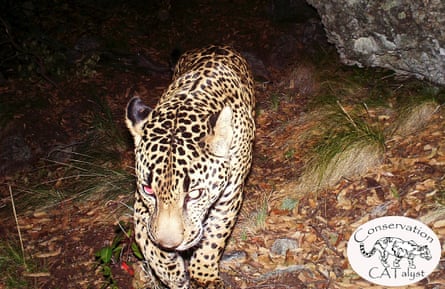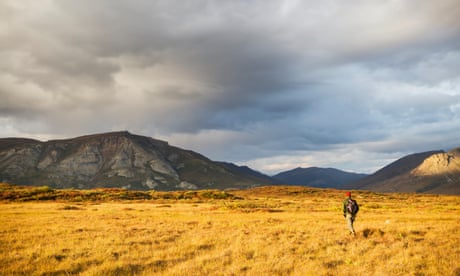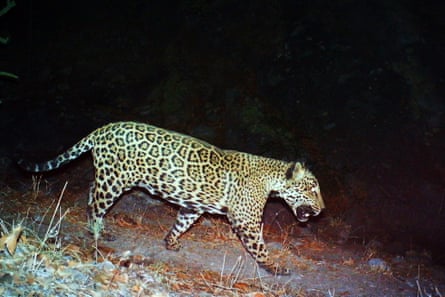Wall is going up in four sections in Arizona’s mountain ranges spanning the US-Mexico border where the cats had reappeared

El Jefe has been photographed repeatedly by remote sensor cameras in the Santa Rita mountains in Arizona over the past few years. Photograph: Reuters
Supported by
.png)
Samuel Gilbert in the Coronado national forest, Arizona
Supported by
.png)
Samuel Gilbert in the Coronado national forest, Arizona
Tue 1 Dec 2020
By the 1960s, the North American jaguar had vanished from the southern US borderland after being hunted to extinction.
Yet in the mid-1990s, there was a remarkable discovery: the jaguar had reappeared in the Sky Islands of Arizona, a region of rugged linked mountain ranges spanning the US and Mexico border that boasts the highest biodiversity in inland North America. Since then, the large cats have been seen over a dozen times in the region, reviving hopes of a full return of the elusive predators to the US.

By the 1960s, the North American jaguar had vanished from the southern US borderland after being hunted to extinction.
Yet in the mid-1990s, there was a remarkable discovery: the jaguar had reappeared in the Sky Islands of Arizona, a region of rugged linked mountain ranges spanning the US and Mexico border that boasts the highest biodiversity in inland North America. Since then, the large cats have been seen over a dozen times in the region, reviving hopes of a full return of the elusive predators to the US.

“They are coming back because the Sky Islands are their home,” said Dr Aletris Neils, the director of CATalyst, a wild cat conservation organization that runs the only jaguar monitoring project in the US. “All we have to do is let them.”
These hopes are threatened by Donald Trump’s border wall. In four years, his administration has built some 400 miles of the border wall in increasingly remote regions of the border. The barrier has severed wildlife corridors and fragmented crucial habitats for numerous endangered and threatened animals, including the wide-ranging jaguar.
Trump’s lame-duck period is no respite: the wall is currently going up in four sections in the Sky Islands, where “grizzly bears and grey wolves mix with tropical species like ocelots and jaguar”, said Neils. “There is no place like it on this planet. [The Sky Islands] are perfect for jaguars.”
“If all contracts are complete, 93% [of jaguar territory] will be blocked and walled off,” said Myles Traphagen, the borderlands program coordinator for Wildlands Network, who mapped the impact of current wall contracts in jaguar territory.

A Mexican jaguar dubbed ‘the Boss’ is seen in Tucson, Arizona, in a photo provided by the US Fish and Wildlife Service in 2017. Photograph: USFWS/EPA
The wall cannot be completed in the next two months, but damage can still be done in remote areas. According to Traphagan, construction is occurring at nearly a mile a day along the entire border, and in some of the last remaining jaguar corridors in the Sky Islands, including a stretch of open border in the Pajarita wilderness as well as the Buenos Aires national wildlife refuge.
In recent years, signs of the jaguars and other endangered cats such as the ocelot have decreased as border wall construction has ramped up in the Sky Islands. “There have been fewer jaguar detections since border wall construction exploded than in any previous year since monitoring began,” said Neils.
Researchers say a permeable border allowing the jaguar and other animals to move freely is essential, yet narrow slats in the new wall prevent all but the smallest of creatures from climbing through it.
Coronado national forest, where ocelots and jaguars had once frequently been documented, is an area of concern. When the Guardian visited in early November, bulldozers were busily grading a steep road over the Huachuca mountains into the Coronado national forest.
“This is jaguar country,” said Emily Burns, standing atop Montezuma Pass, looking down at a stretch of still-unwalled border in the Coronado national forest where the future barrier is set to be built.
Burns is director of the Sky Island Alliance, a non-profit working to protect and restore the Sky Islands’ diversity. Eighty-four species have recently been documented by the alliance’s wildlife-monitoring project and its wildlife cameras, including bobcats, javelinas (a favorite jaguar snack), and recently a mountain lion with her two cubs.
Burns notes that three dozens laws, including the Endangered Species Act and National Environmental Protection Act, have been waived to allow construction in the Sky Islands.
And construction carries its own dangers. On a visit to the wildlife camera at the perennial Yaqui spring, where the mountain lion family was recently photographed, the pools were dry. The likely culprit, according to Burns, was groundwater pumping by nearby border wall construction crews.
Neils, the director of CATalyst, and her husband, Chris Bugbee, would know. The two have spent the better part of two decades researching jaguars in the Sky Islands. Bugbee, an ecologist and senior researcher at CATalyst, has spent thousands of hours tracking the famous “El Jefe” jaguar with the help of his dog Mayke, who he trained to identify big-cat scat and bark to notify his owner.
“I always felt a very strong connection with El Jefe,” said Bugbee. The 210-pound cat had a taste for skunks (minus the odiferous end) and a telltale marking in the approximate shape of the state of Arizona.
But in an echo of the broader decline in jaguar numbers, El Jefe has not been seen for years.
The wall cannot be completed in the next two months, but damage can still be done in remote areas. According to Traphagan, construction is occurring at nearly a mile a day along the entire border, and in some of the last remaining jaguar corridors in the Sky Islands, including a stretch of open border in the Pajarita wilderness as well as the Buenos Aires national wildlife refuge.
In recent years, signs of the jaguars and other endangered cats such as the ocelot have decreased as border wall construction has ramped up in the Sky Islands. “There have been fewer jaguar detections since border wall construction exploded than in any previous year since monitoring began,” said Neils.
Researchers say a permeable border allowing the jaguar and other animals to move freely is essential, yet narrow slats in the new wall prevent all but the smallest of creatures from climbing through it.
Coronado national forest, where ocelots and jaguars had once frequently been documented, is an area of concern. When the Guardian visited in early November, bulldozers were busily grading a steep road over the Huachuca mountains into the Coronado national forest.
“This is jaguar country,” said Emily Burns, standing atop Montezuma Pass, looking down at a stretch of still-unwalled border in the Coronado national forest where the future barrier is set to be built.
Burns is director of the Sky Island Alliance, a non-profit working to protect and restore the Sky Islands’ diversity. Eighty-four species have recently been documented by the alliance’s wildlife-monitoring project and its wildlife cameras, including bobcats, javelinas (a favorite jaguar snack), and recently a mountain lion with her two cubs.
Burns notes that three dozens laws, including the Endangered Species Act and National Environmental Protection Act, have been waived to allow construction in the Sky Islands.
And construction carries its own dangers. On a visit to the wildlife camera at the perennial Yaqui spring, where the mountain lion family was recently photographed, the pools were dry. The likely culprit, according to Burns, was groundwater pumping by nearby border wall construction crews.
Neils, the director of CATalyst, and her husband, Chris Bugbee, would know. The two have spent the better part of two decades researching jaguars in the Sky Islands. Bugbee, an ecologist and senior researcher at CATalyst, has spent thousands of hours tracking the famous “El Jefe” jaguar with the help of his dog Mayke, who he trained to identify big-cat scat and bark to notify his owner.
“I always felt a very strong connection with El Jefe,” said Bugbee. The 210-pound cat had a taste for skunks (minus the odiferous end) and a telltale marking in the approximate shape of the state of Arizona.
But in an echo of the broader decline in jaguar numbers, El Jefe has not been seen for years.
























